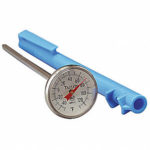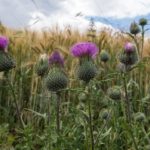Food Temperature
Most disease causing bacteria grow within a temperature range of 41°F (5°C) to 135°F (37°C). This range of temperature is commonly referred to as the “Temperature Danger Zone”. A few disease causing bacterias, such as Listeria monocytogenes, can grow at temperatures below 41°F (5°C) but the rate of growth is slow.
Maintaining a safe food temperature is an effective and essential part of food safety. Thermometers can be used effectively to measure the temperature of stored, cooked, held and reheated foods.
| Thermometer Type | Uses |
|---|---|
| Dial face, metal stem type | Most common type used Used to measure internal food temperatures Measures temperatures using 2 degree increments Stem must be inserted at least 2" into the food being measured |
| Digital | Displays the temperature numerically Measures a wider range of temperatures than a dial face |
| Thermocouple | Provides a digital readout of the temperature Wide variety of interchangeable probes available Sensing portion is often at the tip of the probe |
| Infared | Measures the surface temperature without actually touching the food Requires about 20 minutes to adjust for use for hot and cold temperatures before can be used again Accuracy must be checked frequently |
When and How to Calibrate a Thermometer
Before using a thermometer it needs be calibrated to ensure it is working correctly.
Dial-face metal stem type thermometers should be calibrated:
- Before their first use
- At regular intervals
- If dropped or damaged
- If used to measure extreme temperatures
- If accuracy is in question
Calibrate dial face thermometers using one of two methods, boiling point or ice point. A pair of pliers or an open ended wrench will be needed to adjust the thermometers indicator needle.
Boiling Point Method
Immerse at least the first 2 inches of the stem from the tip into boiling water and adjust the needle to 212°F (100°F). Remember at high altitude the temperature of the boiling point will vary. As atmospheric pressure decreases, water boils at lower temperatures. At sea level, water boils at 212 °F. With each 500-feet increase in elevation, the boiling point of water is lowered by just under 1 °F. At 7,500 feet, for example, water boils at about 198 °F. Because water boils at a lower temperature at higher elevations, foods that are prepared by boiling or simmering will cook at a lower temperature, and it will take longer to cook.
| Altitude, ft | Boiling Point of Water, Farenheit |
|---|---|
| 0 | 212 |
| 500 | 211.1 |
| 1,000 | 210.2 |
| 2,000 | 208.4 |
| 5,000 | 203 |
| 6,000 | 201.1 |
| 8,000 | 197.4 |
| 10,000 | 193.6 |
| 12,000 | 189.8 |
| 14,000 | 185.9 |
| 15,000 | 184.1 |
Ice Point Method
Insert the probe into a cup of crushed ice. Add enough cold water to remove any air pockets that may remain. Wait until the temperature stabilizes and adjust the needle to 32°F (0°C).
How to Measure Food Temperatures Accurately and Safely
- Use a food safe measuring device that measures temperature from 0°F (-18°C) to 220°F (104°C)
- Locate the sensing portion of the measuring device ( on bi-metal the sensing portion extends from the tip to the “dimple” mark, typically 1″ up the stem; digital and thermocouple thermometers sensing portion is closer to the tip)
- Calibrate the measuring device
- Clean and sanitize the probe
- Measure the internal temperature by inserting probe into the center or thickest part of the food item, at least 2″ for dial thermometers and 1″ for digital
- Wait for temperature to stabilize
How to Clean and Sanitize a Food Thermometer
- Wash the stem of the thermometer with soap and hot water to remove any stuck on particles and grease. This will help to remove most common surface bacteria as well. Do not submerge the entire thermometer.
- Rinse with clean water and dry before sanitizing
- Sanitize using an alcohol towelette, white vinegar, submerging in boiling water for 30 seconds, or in food safe sanitizing solutions such as diluted bleach and water for at least 10 seconds.
- Wash with soap and hot water to remove any residue and remaining sanitizing solution



